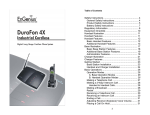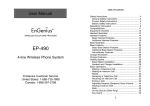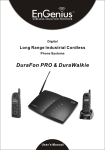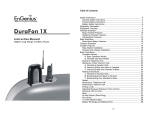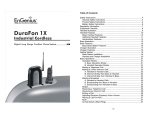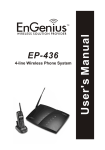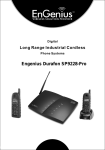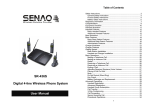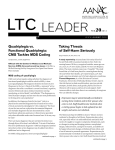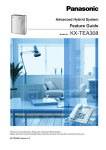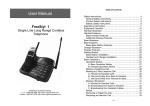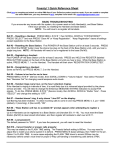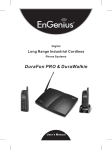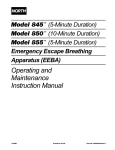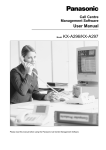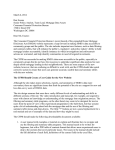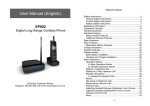Download EnGenius DuraFon 4X User`s Manual
Transcript
EnGenius DuraFon 4X User’s Manual Table of Contents Safety Instructions ....................................................... 3 General Safety Instructions ...................................... 3 Product Safety Instructions ...................................... 3 Battery Safety Instructions ....................................... 5 Regulatory Information................................................. 6 Congratulations............................................................ 7 Equipment Checklist .................................................... 8 Handset Illustration ...................................................... 9 Handset Features ........................................................ 9 Handset Features ...................................................... 10 Basic Handset Features ......................................... 10 Additional Handset Features .................................. 11 Base Illustration ......................................................... 13 Basic Base Station Features .................................. 14 Additional Base Station Features ........................... 15 Administrator Features ........................................... 15 Charger Illustration..................................................... 17 Charger Features....................................................... 18 Getting Started........................................................... 19 Base Station Installation......................................... 19 Handset and Charger Installation ........................... 20 Basic Operations........................................................ 21 Operation Modes.................................................... 21 A. Base Operation Modes................................... 21 B. Handset Operation Modes.............................. 21 Making a Telephone Call........................................ 22 Making a 2-Way/ Intercom Call .............................. 22 Handset to Handset Calls ................................... 23 Making a Broadcast................................................ 23 Redial ..................................................................... 24 Receiving a Telephone Call ................................... 24 Receiving an Intercom Call .................................... 24 Ending a Call .......................................................... 25 Adjusting Receiver (Earpiece) Voice Volume ......... 25 Placing a Call On Hold ........................................... 25 Mute ....................................................................... 25 Do Not Disturb (Silent Ring) ................................... 25 Key Guard .............................................................. 26 To View Missed Call(s)........................................... 26 Battery Recharge and Replacement ...................... 26 Advanced Operations ................................................ 27 Handset Registration.............................................. 27 Advanced Registration: .......................................... 27 Handset Group Subscription .................................. 28 Call Transfer........................................................... 29 3-Way Conferencing............................................... 29 Call Forwarding ...................................................... 30 Auto-Attendant (AA) ............................................... 31 Call Waiting ............................................................ 32 AA Configuration by Administrator ......................... 32 Change AA Parameters ......................................... 32 Line Dedication....................................................... 43 Line Selection......................................................... 33 Change System Settings by Administrator ............. 34 Phonebook Operations........................................... 34 Technical Specifications ............................................ 53 Safety Instructions Caution: Your wireless telephone gives you freedom and flexibility to stay in touch while you move around. However, the safe and responsible use of the phone depends entirely on you. When using your phone equipment, safety instructions should be followed to avoid the risks of fire, electric shock, injury to person, and damage to property. General Safety Instructions 1. When using your wireless phone, ensure your safety and the safety of others: a. Always watch where you are walking and standing. b. Don’t let a phone call distract you from working safely. 2. In an emergency: a. If an emergency occurs, dial the emergency phone number. Remember: if you are in an area where your phone does not have a clear signal from the base, it is highly probable that the call may not go through. Locate the nearest landline telephone or other communications device to call for help. b. Emergency calls may not automatically provide emergency personnel with your name, phone number or location. Tell the operator i) Your name and phone number ii) The nature of the emergency iii) Whether police, fire, or medical assistance is needed iv) The exact location of the emergency, including address, cross streets, mileposts or landmarks. 3. Notice to Hearing Aid Users: This phone system is compatible with inductively coupled hearing aids. 4. Notice to Cardiac Pacemaker Users: Preliminary studies done by the US FDA and others have shown that, although interference to the implanted cardiac pacemaker may occur when operating very closely, wireless telephones “do not seem to pose a significant problem for pacemaker wearers.” However, until more is known, FDA suggests that people with pacemakers may want to take precautions when using or carrying a wireless telephone to ensure that there is ample distance between the telephone and the pacemaker. Do not carry the handset in a breast pocket. If you have any reason to suspect that interference is taking place, turn off your handset immediately. Product Safety Instructions 1. Read and understand all instructions. 2. Follow all warnings and instructions including those marked on the product. 3. Changes or modifications to this product not expressively approved by the manufacturer will void the warranty and the FCC authorization to operate the equipment. Use only manufacturer provided accessories. 4. Do not use the telephone near water. Never spill liquid of any kind on this product. 5. Unplug the product from the wall telephone jack and power outlet before cleaning. Do not use liquid or aerosol cleaners. Use damp cloth for cleaning. 6. Do not place this product on an unstable cart, stand or table. The product may fall and cause personal injury or damage to the product or other property. Place the base station and the charger on hard, flat surfaces. 7. Power Outage: In the event of a power outage, your handset charger will not recharge the handset battery, and the base station will not allow you to make an outgoing call or take an incoming call. Both the charger and the base station require electricity for operation. You should have a telephone that does not require electricity available for use during power outage, or have a temporary backup power supply. 8. Slots or openings in the product’s housing are provided for ventilation. These openings must not be blocked or covered. Placing the product on a bed, carpeting, or other similar surface may block these openings and should be avoided. This product should never be placed near or over a radiator or heat register, or in a built-in installation unless proper ventilation is provided. 9. Never push objects of any kind into this product through housing slots/openings as they may damage the product, touch dangerous voltage points or short out parts that could result in fire, electric shock, or injury. 10. This product should be operated only from the type of power source indicated on the marking label. If you are not sure of the type of power supply to your home, consult your dealer or local power company. 11. Do not overload wall power outlets and extension cords as this may result in fire or electric shock. 12. To avoid electric shock or burn, do not disassemble this product. Send this product to an authorized service center when service or repair work is required. Call Customer Service for locations near you. Opening or removing covers may expose you to dangerous voltages, electrical currents or other risks. Incorrect reassembling of the product may cause electric shock when the product is subsequently used. 13. Avoid using the product during a storm. There may be a risk of electric shock from lightning. 14. Do not place the product where persons can step, trip, or fall on the product. 15. Do not place conductive objects over or near the antenna. 16. Do not use the product to report a gas leak while in the vicinity of the leak. 17. Do not install the base station or the handset charger near microwave ovens, radios, TV sets, speakers, or other electrical equipment. These appliances may cause interference to the product or experience interference from the product. 18. Unplug the base station or the charger adaptor from the wall power outlet and refer servicing to an authorized service center under the following conditions: a. b. c. d. e. f. If liquid had been spilled into the product. When the power supply cord or plug is damaged or frayed. If the product has been exposed to rain or water. If the product does not operate normally by following the operating instructions. If the product has been dropped or housing has been damaged. If the product shows a distinct change in performance. Battery Safety Instructions 1. Use only manufacturer approved Lithium-Ion (Li-Ion) rechargeable batteries and charger. Do not use other types of rechargeable batteries or non-rechargeable batteries. The batteries could short-circuit, and the battery enclosure may be damaged causing a hazardous condition. 2. Follow the charging instruction in this manual and instruction labels and markings in the handset and charger compartments. 3. Battery must be recycled or disposed of properly. Do not dispose the battery in a fire. The cells may explode. 4. Do not dispose of the battery in municipal waste. Check with local codes for disposal instructions. 5. Exercise care in handling the batteries in order not to short-circuit the battery with conductive materials such as rings, bracelets, keys, pocketknife, and coins. The battery or conductive material may overheat and cause burn or fire. 6. Do not expose batteries to rain or water. 7. Do not open or mutilate the battery. Released electrolyte is corrosive and may cause injury to eyes or skin. The electrolyte may be toxic if swallowed. 8. During charging, the battery heats up. This is normal and is not dangerous. Regulatory Information DuraFon 4X FCC ID: NI3-SP922 IC: 3616A-SP922 This device complies with Part 15 of the FCC Rules. Operation is subject to the following two conditions: 1) this device may not cause harmful interference, and 2) this device must accept any interference received, including interference that may cause undesired operation. Privacy of communications may not be ensured when using this phone. 1. The term “IC:” before the radio certification number only signifies that Industry of Canada technical specifications were met. 2. This telephone system complies with rules of the FCC Part 68 and Canadian IC/DOC CS-03. On the bottom of the base station is a label that contains, among other information, the FCC Registration Number, Ringer Equivalence Number (REN) and the Universal Service Order Code, which is RJ-11C in the U.S. or CA-11A in Canada. Your telephone company may ask you for this information. 3. The REN is useful to determine the quantity of devices you may connect to your telephone line and still have all devices ring when your telephone number is called. In most, but not all, areas the sum of the REN’s of all devices connected to one line should not exceed 5.0. To be certain of the number of devices you may connect to your phone line, you should contact you local telephone company for the maximum REN in your area. 4. If your telephone equipment causes problems to the telephone network, the telephone company may ask you to disconnect your phone system from the line until the problem has been corrected. Consult with your local phone company for your rights if this happens. 5. Your telephone company may make changes in its facilities, equipment, operations, or procedures that could affect the proper functioning of your telephone system. Consult with your local phone company for your rights if this happens. 6. This telephone system may not be used on coin service provided by the telephone company. Connection to party lines is subject to state tariffs. 7. This telephone system has been tested and found to comply with the limits for Class B digital devices, pursuant to Part 15 of the FCC Rules and RSS210 of the DOC Rules. These limits are designed to provide reasonable protection against harmful interference in a general public installation. Operations of these devices may still encounter interference from/to nearby TV’s, VCR’s, radios, computers, or other electronic devices. To minimize or prevent such interference, the telephone system should not be placed or operated near other electronic devices. If interference occurs, moving the base station and the handset farther away from them will often reduce or eliminate the interference. 8. However, there is no guarantee that interference will not occur in a particular installation. If this telephone system does cause interference to other electronic devices, which can be determined by turning the system off and on, the user is encouraged to try to correct the interference by one or several of the following measures: a. Increase the space separation between the handset or base station and the device that is experiencing interference. We recommend at least 20 feet between the system and other electronic devices. b. Connect the base station to a power outlet on a circuit separate from that used by the device experiencing interference. c. Consult the dealer or an experienced electronic technician for help. Congratulations You have purchased an exceptional business communications tool from a leading telephone system manufacturer. The EnGenius DuraFon 4X 4-line Industrial Cordless Telephone System is ideal for the users in various business settings. The DuraFon 4X is the longest range, multi-line telephone and 2-way radio communications system providing users unparallel mobility and flexibility. With sophisticated digital signal processing and high quality hardware designs, the DuraFon 4X provides long-range telephone connections and 2-way handset-to-handset communications in a wide variety of business settings from multi-level office buildings, factories, hotels/resorts, convention facilities, warehouses, farms, business complexes, construction sites, school, car dealerships, grocery, retail stores and other demanding business environments. The unique 2-way radio feature allows handsets to communicate with each other as digital, fullduplex 2-way radios. Members of work group(s) can be in contact with their co-workers while leaving phone lines available for incoming and outgoing calls. Handsets that are within range of each other can use the 2-way feature even while out of range of the base station. DuraFon 4X can support up to 90 handsets. Important Warranty Note: U.S. customers: This EnGenius product has NO manufacturer’s warranty unless purchased from an EnGenius Authorized Reseller. To verify a reseller is authorized, please visit our website at: www.engeniustech.com or contact us at 714-432-8668. Equipment Checklist 1. In a Base + Handset package, please find the following components: a. Base Station x 1 b. Base Antenna x 1 c. Base AC/DC Adaptor x 1 d. Handset x 1 e. Low Profile Handset Antenna x 1 f. Optimal Performance Handset Antenna x 1 g. 1700mA Li-ion Battery Pack x 1 h. Charger x 1 i. Charger AC/DC Adaptor x 1 j. Telephone Cord x 4 k. Belt Clip x 1 h User’s Manual, Quick Guide, and Warranty Card 2. In a Handset package, please find the following components: a. Handset x 1 b. Low Profile Handset Antenna x 1 c. Optimal Performance Handset Antenna x 1 d. 1700mA Li-ion Battery Pack x 1 e. Charger x 1 f. Charger AC/DC Adaptor x 1 g. Belt Clip x 1 h. Quick Guide, and Warranty Card 3. Optional Accessories a. Outdoor Antenna Kit (including antenna and cable) b. Lightning Protection Kit (including cable) c. DuraPouch d. Belt Clip e. Spare Battery f. Low Profile Handset Antenna g. Optimal Performance Handset Antenna h. Headset i. Antenna Splitter (including cable) j. Audio-in Cable Handset Illustration Antenna Receiver 4-line LCD Battery pack Headset jack (2.5mm) Travel charger jack Handset Features Basic Handset Features 1. 4-line LCD (Liquid Crystal Display) a. The LCD display has LED (Light Emitting Diode) for backlighting. b. The 1st line of LCD consists of icons. c. Icons explanation from left to right (1) RSSI (Receive Signal Strength Indicator) During a call, the number of bars is proportional to the radio signal strength received. (2) Call in-progress (ON/OFF-Hook) Indicates if phone line mode is active (3) Intercom in-progress Indicates if Intercom mode is active (4) Handset ID Displays a handset icon and a 2-digit Handset ID (5) Two-Digit Address Index Shows address index when viewing contents of the call logs. (6) Line Indicator Indicates the number of the line being accessed by the handset. (7) Battery Strength z Number of bars is proportional to the amount of battery time remaining. z Indicates charging when in charger cradle. d. The 2nd and 3rd lines of the LCD, maximum 14 characters each, display status, message, menu selections, or usereditable alphanumerical characters. e The last line displays the left and right soft keys. 2. Ringer a. Rings to an incoming call. b. Distinctive alert sounds indicating various events: (1) Single Beep: successful key entry (2) Double beep: failed operation or invalid key entry, also indicates power on/off (3) Periodic 1-Long-2-Short Beep (every 1 minute): low battery warning (4) Periodic Long Series of Beeps (repeat every 30 seconds): indicates a call is on-hold 3. TALK/FLASH a. Places or answers a telephone or intercom call b. Sends a Flash signal to phone line to retrieve a dial tone after the call ends, or to perform the call waiting feature provided by local phone companies during a call. 4. 2-WAY/INTERCOM a. Places an intercom call to another handset ID or a group ID. b. Intercom calls are digital, full duplex, and are conducted without the assistance from the base. 5. BROADCAST a. Half duplex broadcasting to handsets for immediate announcement 6. Left/Right Soft Keys a. Make menu selection. 7. Up(¿) /Down(À) Scrolling Keys a. Scroll through records and menu selections. b. Adjust receiver voice volume when in Talk mode. 8. END; On/Off Key a. Ends a call. b. Leaves current menu operation, up one level. c. Press for 3 seconds to off the power Additional Handset Features 1. Multiple handsets registration a. Up to 90 handsets. b. ID 10 and 11 are the first two ID’s assigned by the base and are designated “administrators” who can change base settings such as greeting message and other base administrative functions. c. ID 01-09: Group IDs. Handsets can “subscribe” from the handset menu to group(s) and be paged when a landline caller or an intercom caller enters a Group ID. 2. Ringer / Vibrator a. Six-level ringer volume selections (high/ medium/ low/ vibrate/ vibrate-then-ring/ off) b. Four ringer type selections 3. Caller ID a. Displays incoming call phone number and name on the LCD (needs Caller ID service from local telephone company) 4. Call Waiting with Caller ID a. Displays 2nd incoming call information on the same phone line when 1st call is in progress (needs Call Waiting with Caller ID service from local telephone company) 5. Name Tagging with Caller ID a. Matches the Caller ID with the phone book entries; once matched, the LCD screen will display the name or nickname instead of pure Caller ID info (needs Call Waiting with Caller ID service from local telephone company) 6. DND (Do Not Disturb, i.e., Silent Ring) 7. Three Call Logs a. Called Log: Stores 10 phone numbers (up to 28 digits each) dialed most recently. Can perform last-number redial on all 10 numbers. b. Received Call Log: 10 entries (14-digit phone number, 14character names, and time stamp), needs Caller ID service from local telephone company. c. Missed Call Log: 10 entries (14-digit phone number, 14character names, and time stamp), needs Caller ID service from local telephone company. d. Phone numbers and names can be saved into phonebook while in display. 8. Call Barring a. Block the users from dialing the long distance calls or international calls b. Up to 5 digits of each call barring setting; up to 4 entries allowed c. If you need to dial a specific number to retrieve the dial tone, you need to key in that number while setting the call barring [Note] you need to key in the accurate user ID and password to perform this feature. The default password is 0000. 9. Any Key Answer (except END, Silent Soft Key) 10. Key-guard 11. Dialing Prefix a. Up to 14 digits, including pause(s), one access code can be pre-programmed to be added automatically in front of the dialed number when dialing from call logs, phonebook, and dial-and-send dialing. 12. Call Hold a. Places call on hold b. Battery Hot Swap: Change battery while call is on hold. 13. Mute 14. Phonebook a. 30 entries, each stores a phone number or handset ID (up to 28-digit) and name (up to14-character) b. Alphabetically sorted display and search by letter c. Dial from display d. During the stand-by mode, you can enter the phonebook by pressing ¿orÀ scrolling key 15. Key Tone a. Three-level key-tone volume selections (high/low/off) b. Four key-tone type selections 16. Call Timer a. Display call time duration for current call during and immediately after the call 17. Text Messaging: a. Editing Message: from a handset, users can edit the short text message for up to 50 characters. Up to 5 messages can be edited and stored. b. Sending Message: In view mode, handset can send a message to another handset or a group of handsets. c. Incoming Message: A distinctive tone alerts an incoming message. The message will stay on LCD display for 8 seconds and then is saved in memory. A total of 5 incoming messages can be saved. 18. Call Transfer a. Direct Transfer: transfer a telephone call to another handset without announcement. b. Announced Transfer: speak to the destination handset before transferring a telephone call. 19. Call Forwarding a. Forward all incoming phone calls to another handset. b. Forward all incoming phone calls to another landline or cellular phone number. [Note] (1) Once enabled from the handset, all phone calls will be routed to the designated number until disabled. A warning message will appear on the LCD. (2) Intercom calls are not forwarded. (3) Before setting this feature, please check your PBX system if it can send a reverse signal to hang up the line. 20. Call Conferencing a. 2-handset and 1-line conferencing. b. 1-handset and 2-line conferencing. 21. Line Selection a. When enabled from the handset menu, a handset user will be prompted to select from a list of available lines before making an outgoing call. Base Illustration Base Features AUDIO L4 L3 L2 5. Line in L1 DC IN 2. Audio in 6. DC in Basic Base Station Features 1. Antenna a. The antenna port has a reverse thread connector; to remove antenna or cable, turn clockwise; to install, turn counterclockwise. Improper installation may damage the connector b. When using an outdoor antenna, locate the antenna (not the base station itself) as high as possible for a clear transmission path. 2. LED a. Power: it indicates base station has power. b. In-Use: it indicates an active telephone line. 3. Reset Button a. Restores base station to factory settings b. Reset button is indented to prevent accidental system reset. c. All handsets (including administrator) and additional base(s) need to be re-registered after a base station reset. 4. Registration Key (REG) Enters registration mode along with handset, assigns handset ID (10-99). 5. L1 – L4 Standard RJ-11C/CA-11A connector to plug in the telephone line 6. Audio-in Jack (3.5mm) 7. DC In: to plug in the power adaptor Additional Base Station Features 1. 4-channel Auto-Attendant a. 4 Auto-Attendant can be active at the same time in case of 4 simultaneous incoming calls. b. Allows private paging to a single handset (with individual Handset ID) or group paging to a group of handsets (with Group ID). c. Per line AA enable/disable by administrator. When disabled for a line, the administrator can set all handsets to ring with an incoming call on that line, or a particular Handset/Group ID (either one; not simultaneously) can be assigned to have both incoming and outgoing call privileges on that line. See AA Configuration by Administrator. d. Up to 128 seconds customizable main greeting message. 2. Optional Outdoor Antenna Kit with cable Administrator Features Handsets 10 and 11 are designated administrators. Both have the same authority to perform base station administrative functions from their handset menu selections. No password is required. 1. Supports both DTMF and Pulse dialing a. From an administrator handset (Handset 10 or 11 ), press MENU-92-3 to select Tone or Pulse dialing mode. b. Default is Tone dialing. 2. Administrator programmable Flash key timing a. From an administrator handset (Handset 10 or 11), press MENU-9-24 to select flash key timing b. 9-level (100 ms - 900 ms) timing selections, default= 600 ms. c. The default value (600 ms) works in most areas. Changing this setting may result in Flash function not working. Change only when you are certain of the new value would work. 3. Call Transfer to PBX Extension a. When install the DuraFon 4X is installed behind a PBX system, you can pre-program the feature code of call transfer function. b. Need to adjust the Flash time to match your PBX setting. Charger Illustration DC In Spare Battery Charging Slot Spare Battery Charging Indicator Handset Charging Slot Charger Features 1. DC In Connects to Charger AC Adaptor. 2. Handset Charging Slot a. Charge handset battery when handset is placed in cradle. b. Refer to the handset LCD for charging status (1) Charging: LCD screen showed “Charging” (2) Fully Charged: battery status bar stands still and the LCD screen would display “Fully Charged” (3) Charge Fail: Should there be any error occurred during charging mode, the LCD screen would display “Charge Fail” 3. Spare Battery Charging Slot a. Charge spare battery when battery is placed in slot. b. LED as the spare battery charging indicator (1) Slot is empty and the power is on: LED is Green light (2) Charging: LED is Orange light (3) Fully Charged: LED returns to Green light 4. It is impossible to overcharge the battery using this charger. 5. The adaptor for charging station can be used as travel charger as well. However, you can not turn off the power while charging with the travel charger. A Warning message: “Unplug Travel Charger than OFF the power” will be shown on the LCD display. Notes: I. Fully charge battery packs before first use. II. Both handset and spare batteries can be charged at the same time. III. Handset will be “power on” automatically when placing on the charging slot. IV. However, if you run drain the battery, it would take around one minute for handset to auto power on. Getting Started Base Station Installation There are three possible base station setups: z Base station alone z Base station plus telephone answering device z Base station plus standard telephone For best performance, maintain at least a distance of 1 meter (about 3 feet) between the base station and other electronic devices (e.g., TV, computer, stereo, fax machine, answer machine, cordless phone, etc.) 1. Install base station antenna. The base station’s antenna port has a reverse-thread connector; to install antenna or cable, turn counter-clockwise; to remove, turn clockwise. Improper installation may damage the connector. 2. Plug the transformer end of the base station AC/DC adaptor into a standard AC electrical power outlet, plug the other end into the “DC In” jack on the back of the base station. a. The base adaptor’s DC plug is larger in dimension than the charger’s DC plug. The charger adaptor’s DC plug will not fit into the base’s DC In jack. b. The base station’s power supply (DC Adaptor) and telephone line should be plugged into a surge protector with phone line protection. 3. Plug one end of the phone cord into one of the 4 phone jacks marked L1 – L4 and plug the other end into the telephone outlet. Since DuraFon 4X has the built-in “line detection” feature, it is okay to plug in the phone jacks in random order. 4. Connect an external telephone answering device by follow instructions that come with the answering device. An exemplary configuration: install the external answering device in-between the wall phone jack(s) and the Base Station. Either a multiple of single-line answering devices or a multipleline answering device can be used. You may want to disable the Base Station’s Auto-Attendant function if that interferes with the external device’s built-in Auto-Attendant. 5. To use the Music/Message-On-Hold feature: Connect one end of a standard audio cable into a radio or audio player, and plug the other (3.5 mm) end into the MOH jack on back of the base. Notes: Recommended phone line features from the local phone company: Multiple phone lines “hunt group” is a useful feature and works well with this phone system. This feature “ties” multiple phone lines to a single phone number. When an outside caller calls this common phone number, the phone company automatically finds a free line. In a hunt group, the Call Waiting and the Caller ID with Call Waiting (or called Type II Caller ID) features are unnecessary because a 2nd call will come in on a separate line, rather than on the same line. For a 2nd call coming in on a separate line, the phone system’s built-in Call Waiting feature will alert the user and allow the user to toggle between 2 lines. Handset and Charger Installation 1. Plug the transformer end of the Charger AC/DC adaptor into a standard AC electric power outlet, plug the other end into the “DC In” jack on the back of the Charger. 2. Install battery pack onto the handset. 3. Install handset antenna. 4. Place handset onto the charger front slot. 5. The phone system is now ready to perform basic functions such as making and receiving phone calls and intercom calls. No base station or handset programming is needed for basic operations. 6. Charging cradle may be wall mounted, but an “L” bracket should be used for support under the cradle to avoid breaking mounting slots. An “L” bracket is not included, but can be purchased from a local home center. Note: 1. The handset packaged along with a Base Station is preregistered at the factory. If you have a new handset, you will need to register the handset with the base station in order to be recognized as a member handset by the base and by other handsets. See Handset Registration. 2. Fully charge battery packs before the first usage. Basic Operations Operation Modes Both the base station and handset have levels of operation at which time only certain procedures of functions can be performed. A. Base Operation Modes 1. IDLE mode- this is the default mode. The intercom, broadcast, and volume keys are active in IDLE mode. 2. TALK mode- the base operates in this mode during phone call, intercom, and broadcast operation. The “In Use”, “Intercom”, and “Broadcast” LED will light up respectively. 3. REGISTRATION mode- the base enters this mode by pressing the REG button for three seconds. There are no active base unit keys once this mode has been entered. Four LEDs will light up in Registration mode. B. Handset Operation Modes 1. IDLE mode- this is the default mode. a. If there is no on-going activity, the handset automatically goes into SLEEP/IDLE mode to save battery power. b. The handset can be turned off completely by holding down the END key for 3 seconds. c. The idle screen display (custom name) can be edited. d. The 2-digit number represents the handset ID. 2. Menu mode a. Press the Right soft function key to activate MENU mode. b. In MENU mode, the handset settings and information contained in memory can be changed. c. The functions available through the MENU selection are covered in greater detail from page 50. d. The MENU structure display as below: Main menu 1.KeyGuard 2.PhoneBook 3.Call Logs 4.Sound 5.Settings 6.Registration 7.Text Message Sub-menu 1.Dialed 2.Received 3.Missed 1.Ring Volume 2.Ring Tone 3.Key Volume 4.Key Tone 1.Dial Prefix 2.Group Select 3.Forwarding 4.Clear 5.Naming 6.Contrast 7.Backlight 8.Line Select 9.PBX Options 0.Language 8.Unused Not Applicable 9.Admin 1.Auto Attndnt 2.System Making a Telephone Call 1. Press TALK, wait for dial tone, and then enter phone number. 2. Alternatively, you can enter phone number first then press TALK key. When using this method, you can use the CLEAR (Left) and DELETE (Right) soft keys to edit the number entered. “Delete” erases the last digit entered. “Clear” erases the entire line but remains in the dialing mode. 3. Speed dial by access the entries in the phone book a. Press ¿orÀ scrolling key to enter the phone book b. Press TALK to dial the number. 4. To abort dialing, press END key. Notes: 1. After a link established, the Base ID will appear on the upper2. 3. 4. right corner. If no Base ID show up, it applied that you are approaching the boundary of the coverage. If the line is occupied, the LCD shows “No Line Available” and handset returns to standby mode. If a link cannot be established, the LCD will show “No Base” after a 12-second time out. A call duration timer will start displaying the length of the call after link is established. Making a 2-Way/ Intercom Call The EnGenius Industrial Cordless Phone System offers private, Intercom/ 2-way radio calls independent of the base station. Intercom/ 2-way communication can be placed from handset to handset. Handset to Handset Calls 1. Press Intercom key followed by a two-digit handset ID or Group ID. 2. Press END key to end the call. Notes: 1. Intercom calls can be made regardless if the Base Station is present. 2. If a Group ID is entered, the first handset (belonging to that group) that answers will establish a link with the caller. See Handset Group Subscription. 3. If a link cannot be established, the LCD shows “No Connection” after a 12-second time out. Making a Broadcast 1. Broadcasting all handsets a. Press BROADCAST key from one handset b. Hear bi-bi-beep while the initiating handset broadcast all handsets within communication coverage c. Start to speak the message to be broadcasted once you hear the “beep” sound; the speakerphone of destination handsets will be opened up d. Release BROADCAST key to end the broadcasting 2. Broadcasting a group of handsets a. Enter the Group ID and then press BROADCAST key b. Hear bi-bi-beep while the initiating handset broadcast all handsets within communication coverage c. Start to speak the message to be broadcasted once you hear the “beep” sound; the speakerphone of destination handsets will be opened up d. Release BROADCAST key to end the broadcasting 3. Broadcasting an individual handset a. Enter the Handset ID and then press BROADCAST key b. Hear bi-bi-beep while the initiating handset broadcast all handsets within communication coverage c. Start to speak the message to be broadcasted once you hear the “beep” sound; the speakerphone of destination handsets will be opened up d. Release BROADCAST key to end the broadcasting Notes: 1. You need to continuously press BROADCAST key when doing broadcast. The broadcast will be over once user release the key. 2. You need to notice that there is no bi-bi-beep sound when receiving a broadcast. 3. You can press the SILENT (Left) soft key if you choose to ignore the call. The SILENT key operation is valid only for the current call. You can silent all broadcast by turning off the ringer to set auto-silence from the handset menu. Redial 1. Press REDIAL (Left) soft key. 2. The LCD shows the last phone number dialed. To dial this number, press DIAL (Left) soft key. 3. Use Up or Down Arrow Key to scroll through the last 10 phone numbers dialed. Select and press DIAL key. [Note] Intercom numbers (Handset ID) are not stored in the last 10 numbers dialed log. Receiving a Telephone Call 1. When an incoming call arrives, the ringer will ring or vibrate unless the ringer has been turned off. 2. If the handset is on the charger cradle (ringer will be temporarily switched to “Ring” if it has been set to “Vibrate”), lift the handset and start the conversation. 3. If the handset is not on the cradle, press any key (except END, and the Silent soft key) to answer. Notes: 1. You can press SILENT (Left) soft key if you choose to ignore the call. Unlike turning off the ringer (from the handset menu), the SILENT key operation is valid only for the current call. 2. If Caller ID service is available, the LCD will display the incoming call information. If the LCD shows “Private” or “Unknown”, the caller’s information may have been blocked by the caller or the originating phone company. Receiving an Intercom Call 1. When an intercom call arrives, the ringer will ring or vibrate unless the ringer has been turned off. Press TALK to answer the intercom call. 2. If the handset is on the charger cradle (ringer will be temporarily switched to “Ring” if it has been set to “Vibrate”), lift the handset and start the conversation. 3. If the handset is not on the cradle, press any key (except END and the SILENT soft key) to answer. Notes: 1. The LCD displays the caller’s Handset ID. 2. You can press the SILENT if you choose to ignore the call. Unlike turning off the ringer the SILENT key operation is valid only for the current call. Ending a Call To end a telephone or intercom call, press END key or place handset into charging cradle. Adjusting Receiver (Earpiece) Voice Volume 1. Voice volume can only be adjusted during a call. 2. There are 6 levels of volume selections. Default as volume 4. Use ¿andÀ scrolling key to adjust. 3. The new setting remains effective for all future calls until changed. Placing a Call On Hold 1. When a call is in progress, it can be put on hold by pressing the HOLD (Right) soft key. 2. To return to the conversation, press “UNHOLD” Notes: 1. The call being placed on hold can only be removed from HOLD by the handset that puts it on hold. 2. Handset LCD displays a call is being on hold. An alert tone (double beep) every 30 seconds will remind the handset that a call is being on hold. 3. If the operation (e.g., call transfer) after putting a call on-hold fails, the held call may be dropped. 4. You can power off the handset (e.g., change battery) while call is on hold. After power on again, you can continue the call by pressing UNHOLD (Left) soft key or select “3” from the Option menu to terminate the hold state. 5. You can only unhold the call when within the coverage area of the base. Once you’re out of the base coverage, you can return to stand-by using “Clear hold” function in the OPTION list item #3. Mute 1. After a link is established, you can press OPTION (Left) soft key and press “0” to mute the handset microphone. 2. When mute is active, the other party will not hear your voice, but you can still hear the other party. 3. To end the mute, press “UNMUTE” (Left) soft key. Mute is effective only for the current call. Do Not Disturb (Silent Ring) 1. Enter the key sequence MENU – Sounds – Ring Volume, then select “Off”. Press SAVE to confirm your choice. This will turn off the ringer until it is turn on again from the menu. 2. For temporary silencing the ringer when an incoming call arrives, press SILENT (Left) soft key. Key Guard 1. To prevent accidental dialing, you can press Menu (Right) soft key, then press “1” to select KeyGuard option. The handset keypad is locked. No key entry is accepted except the power on/off key. 2. To unlock the keypad, press “UNLOCK” (Left) soft key, then, within 2 seconds, press the digit “1” to unlock. 3. Key Guard is in effect until unlocked or powered off. To View Missed Call(s) 1. Whenever you have missed incoming call(s), you can press VIEW soft key to enter the call logs information. 2. You need to subscribe the caller ID service from local telecom company to retrieve this data. Battery Recharge and Replacement 1. Charge the battery when one or several of the following happen: a. Phone beeps twice every two seconds. b. Battery icon is empty. c. Phone does not respond when a key is pressed. d. LCD and backlighting become dim. e. Talk range shortfall is experienced. 2. You can replace the handset battery after placing the call-in-progress on hold. 3. Battery talk time and standby time vary depending on the talk/standby pattern and the operating distance. Returning the handset back to the charging cradle as often as possible is recommended for best performance. Use only manufacturer provided battery and charger! Advanced Operations Handset Registration 1. If your handset is purchased as part of a system, it has been preregistered with the base station at the factory. 2. If the Handset ID reads “00,” that means it is a new handset or the ID has been erased. You need to register the handset with the base station. In certain situations, you may want to change a handset’s ID. For example, you want to change a particular handset from a user to an administrator (ID 10 or 11), or vice versa. Or in some rare occasions, you find another handset having the same Handset ID. 3. Registration: a. Press MENU-6 to enter the registration mode b. Press and hold the base’s Registration (REG) button for 2 seconds until the L1, L2, L3, and L4 LED come on. c. Press handset key “1”, this completes the registration process. The base station will assign a handset ID between 10 and 99. The assigned ID will be displayed on the handset LCD, indicating successful registration. d. Repeat above steps for all additional handsets. e. The first two handsets registered will be given ID 10 and 11, which gives them administrator privileges. 4. De-registration: a. You can de-register a handset from a base. De-registration will reset the Handset ID to 00, erase the system security code, and free up the old ID for future registration. b. After deregistration, the handset will not be able to use the base to make or receive phone calls, nor can it intercom other handsets. c. Press handset MENU (Right) soft key. d. Press the handset number key “6”, this will enter the handset registration menu. e. Press and hold the base’s REG button for 2 seconds until L1, L2, L3, and L4 LED come on. f. Press the handset number key “2”, this completes the deregistration process. Upon successful de-registration, the handset will show ID “00”. Notes: 1. The base has a 30 second registration timeout starting from pressing the REG button. The handset has a 12 second registration timeout starting from the registration or deregistration option has been selected. The base and handset will automatically exit registration mode after timeout. 2. Repeat registration or de-registration process if unsuccessful. Advanced Registration: 1. Advanced registration functions can be performed by administrator handsets (ID 10 and 11) only. 2. Administrator handsets can perform advanced registration function as long as in range with the base station. The base station does not need to be in registration mode. 3. De-register a Handset ID by administrator: a. Make sure that the administrator handset is within the coverage range of the base station. b. Press administrator handset MENU (Right) soft key c. Press the number “9”, this will enter the handset administration menu. d. Press number “2”, handset enters system setting menu. e. Press number “1”, and enter the two-digit Handset ID to be cleared. f. Upon successful operation, the handset LCD will display “Done”, otherwise it will show “Message not received, try again”. 4. Obtain a Specific Handset ID: a. If a particular Handset ID is preferred over sequentially assigned ID, the administrator can “tell” the base in advance what the next ID assignment should be. b. Press administrator handset MENU (Right) soft key. c. Press the number “9”, this will enter the handset administration menu. d. Press number “2”, handset enters system setting menu. e. Press number “2”, and enter the two-digit Handset ID to be assigned next by the base. f. Upon successful operation, the handset LCD will display “Done,” otherwise it will show “Message not received, try again.” g. If the handset ID is already in use by another handset, the administrator will be alerted. In that case, the administrator can choose another ID or asks the handset having the desired ID to vacate by de-registering with the base. h. Perform registration immediately afterward for the handset desiring a specific ID to ensure that the ID is not taken by another handset. Notes: 1. De-registration by the administrator will disable a handset’s ability to use the base station to make or receive phone calls. This also frees up the ID for future registration. 2. Handsets de-registered by the administrator can still perform intercom to other handsets. Handset Group Subscription 1. Up to nine handset groups (01-09) can be defined and handsets can decide which group(s) they want to be in. 2. For example, Group 1 represents the Customer Service Group, Group 2 represents the Sales Group, and Group 3 is the Marketing Group. Suppose that Handset 11 wants to receive incoming rings for all Sales and Marketing related calls. Then handset 11 will need to “subscribe” to Group 2 and Group 3. 3. Group Selections: a. Press handset Menu-5 to enter the handset setting menu b. Press number “2”, handset enters group select menu. c. Press ADD soft key and enter two-digit group number (0109) to add membership in a group. d. Repeat for all desired groups. e. Delete group selections by pressing DELETE (Right) soft key and enter group number. Notes: 1. The handset can change group affiliations at any time. 2. The base (administrator) is not responsible for group assignments. Consequently, it cannot de-subscribe a handset from a group. Call Transfer 1. While a telephone call is in progress, you can place call on hold and transfer the call. 2. Press HOLD soft key to put call on hold. 3. Press OPTION soft key to enter feature list for selection. 4. Press number “2” and enter a two-digit Handset ID to call another handset extension. a. Un-announced Call Transfer: Press “END” before the destination handset answers, the call is automatically transferred to the destination handset. b. Announced Call Transfer: (1) Speak to the destination handset. (2) Press XFER soft key or the END to end announcement. The call is transferred to the destination handset. Notes: If the destination handset does not answer after handset paging timeout, the call is routed back to the originating handset. 3-Way Conferencing 1. While a telephone call is in progress, you can place call on hold and bring in another phone line or another handset for a 3-way conference. 2. Press HOLD (Right) soft key to put the current call on hold. 3. Press OPTION (Right) soft key to enter selection menu. 4. 3-Way Conferencing with a Second Handset: a. Press number “2” and enter a two-digit Handset ID to call another handset extension. b. After the second handset answers, press the CONF (Left) soft key. c. Two handsets and one phone line can now talk simultaneously. Any one party can drop out of the 3way conferencing, leaving the remaining two parties still in conversation. 5. 3-Way Conferencing with a Second Phone Line: a. Press number “1” and enter a phone number to call another phone line. b. After the second line answers, press the CONF (Left) soft key. c. One handset and two phone lines can now talk simultaneously. I. If one phone line hangs up, the handset continues talking to the remaining phone line. II. If the handset presses END key, the 2nd phone line will be dropped. The handset and the first phone line continue conversation. Notes: 1. 3-way conferencing between 3 handsets is not supported. 2. Unlike 3-way conferencing provided by the phone company, 3-way conferencing involving 2 phone lines will take up two physical lines, leaving only two lines left available for other handsets. The handset must have access to a second line. Call Forwarding 1. A handset can direct the base station to forward all future phone calls to be routed to another handset or another phone number. 2. Press handset MENU (Right) soft key. 3. Press the number “5”, this will enter the handset setting menu. 4. Press number “3”, handset enters call forwarding setting mode. 5 Use Up/Down arrow to scroll up and down the selection (Off, Another Handset, External Line). 6. Make a selection (default = Off) and press SAVE (Left) soft key. 7. When prompted, enter a two-digit handset ID or an external phone number, up to 14 digits. 8. A warning message “All calls are forwarded” will appear on the handset LCD. 9. To turn off call forwarding, repeat the above procedures and select “Off”. Notes: 1. Because this setting is stored both on the handset and on the base station, the handset must be in range with the base to change setting. 2. A warning message will appear on the handset LCD to inform the handset that all calls are forwarded. 3. Calls can be forwarded to another handset or a phone number, but not both. Setting a call forwarding address will automatically replace the previous setting. 4. There is no call forwarding announcement, the caller is not aware of the call is being forwarded. 5. Call forwarding can be only one-hop. That is, for example, if Handset 11 forwards calls to Handset 22, but Handset 22 also sets calls forwarding to another handset, calls for Handset 11 are still routed to Handset 22. Auto-Attendant (AA) 1. When enabled by the administrator, an automated attendant would greet a telephone line incoming call. 2. The caller will be prompted by the greeting message to enter a two-digit extension number (Handset ID) or press “0” for operator. 3. The greeting message is user programmable. The Handset ID that is designated as the operator is also user programmable. I. II. Default greeting message (Main OGM): “Please enter the extension number or press 0 for the operator.” Default operator: Handset 10. 4. AA will ask for another handset ID if the first entry is invalid (no registered handset with that ID) with the announcement (OGM2): “The extension you entered is invalid, please try another extension or press 0 for the operator.” 5. If there is no entry after time out, AA will announce (OGM3): “Please hold, your call is being transferred to the operator.” and automatically ring the operator handset. 6. If the destination handset does not answer (busy, power off, or out of range) after handset paging time out, the AA prompts the caller for another extension number by announcing (OGM5): “The extension you’ve entered is busy or not available. Please enter another extension number or press 0 for the operator.” 7. If the 2nd try is still not successful, AA will announce (OGM4): “Sorry, nobody can answer your call right now. Please try again later, goodbye.” then drops the call. 8. When the DURAFON 4X base station is connected to wired PBX extension lines, calls addressed/routed to the AA operator can be sent back to the operator of the wired PBX system. From an administrator handset, up to 10 keys/digits are allowed to program a specific code in order to transfer the calls back to the wired PBX. This feature can only be enabled and pre-programmed by an administrator handset (Handset ID 10 or 11). Consult with the wired PBX manual for operation instructions and correct key sequence for transfer calls to the operator from an extension. Notes: 1. Intercom calls are not routed by Auto-Attendant. 2. Routing messages OGM2, 3, 4, and 5 are not user programmable. 3. The timeout is 5 seconds for entering extension number. 4. The calls can be routed to either a Handset ID or an extension number of the wired PBX system. There can be only one operator for the AA, which is either an DURAFON 4X handset or the wired PBX operator. 5. Call routing is at most 2 hops. That is, if both the 1st and the 2nd handsets do not answer, the call will be terminated. Call routed to the operator is final and will be terminated if the operator does not answer. Call Waiting 1. A handset, while talking on one phone line, can be informed of the arrival of a new incoming phone call. 2. For example, suppose that Handset 15 is talking on Line 1. When a new call comes in on, say, Line 4, and the caller enters extension number “15” when prompted by the AA, or if the call is set to be routed to Handset 15 when AA is disabled. 3. The base station recognizes that Handset 15 is busy. Instead of announcing to Line 4 that Handset 15 is busy, the base sends an alert to Handset 15. 4. Upon receiving the alert, the handset sounds an audible double beep alert and LCD displays “New call on Line 4”. 5. Handset 15 can: a. Ignore the new call; continue talking to Line 1. b. Press FLASH key to switch to Line 4. c. Subsequent pressing of FLASH key will toggle between Line 1 and Line 4. d. Press END key while talking to a line will terminate that particular call and automatically switch back to talking to the remaining line. Notes: 1. This built-in call waiting is separate from the Call Waiting feature available from the local phone company. The phone company provided Call Waiting functions on the same phone line, while the Call Waiting functions on two separate phone lines. 2. This feature only works for 2 lines, if a 3rd phone call comes for the same handset, the call will not be routed to the handset. 3. It is recommended to order from the local phone company Hunt Group feature for all your lines and not subscribe to the Call Waiting feature. AA Configuration by Administrator 1. Administrator can change the following AA settings: a. Record/playback new main greeting message. b. Set number of rings before AA picks up a call. c. Turn on/off the AA line-by-line. d. Set Designated Handset ID for AA disabled line(s). Either the Designated Handset ID or the Group ID can use that particular line for incoming and outgoing calls. Which means this specific line(s) will be dedicated to a particular handset (Handset ID 10-99) or a calling group (Group ID 01-09.) e. Designate an operator, the handset which would answer un-routable calls or when the caller chooses “Operator” when prompted. Change AA Parameters: a. From an administrator handset (Handset 10 or 11), press Menu (Right) soft key. b. Press number “9”, this will enter administration menu. c. Press number “1”, handset enters AA setting menu. i. Press “1” and follow instruction to record new greeting message. ii. Press “2” to playback the current greeting message. iii. Press “3” to set number of rings before the AA picks up a call. Use Up/Down arrow to choose between 2 and 9 rings. iv. Press “4” to turn AA On/Off: This can be done separately for each phone line by using Up/Down arrows to scroll through Line 1 to Line 4, and press “On” or “Off” soft key to urn AA On/Off. When AA is turned off, users will be asked whether to dedicate a particular to either a handset or a calling group. Then press Yes and enter the ID (either handset ID or group ID) to execute line dedication. Turning off the AA may be useful when: • The line is not used by a group of people. • External answering machine is to be attached to the line. v. Press “5” and select from the following two options to set Operator for AA: • “Handset” : assign a specific handset as operator by entering a two-digit handset ID (default = Handset 10) as operator for all calls addressed to the operator when AA is on, or • “PBX”: transfer calls to be answered by the operator back to the designated wired PBX operator. System administrators must know the proper programming and “call transfer” feature code (available from the user manual of the wired PBX system) in order to perform this function correctly. The following example is the instruction to route a call back to the brand N’s PBX system by pressing “Flash-7-0-1-8-3-0,” where a Flash key is pressed followed by the call transfer code”70”, then enter the extension number “1830” immediately. Confirm the set up by press “SAVE” using the left soft key. Notes: 1. Only administrator can change AA settings. 2. Because AA setting is stored on the base station, the handset must be in range with the base to make changes. 3. The maximum recording time for the greeting message is 128 seconds. 4. Allowing each line’s AA to be turned on or off separately is useful if different lines are used for different purposes. 5. When AA is disabled, the line can be dedicated to either an individual Handset ID or a Group ID. 6. The operator can be any individual handset or a group; it doesn’t need to be an administrator handset (Handsets 10 and 11). 7. The minimum number of rings before the AA picks up cannot be lower than two for the purpose of receiving the Caller ID message. Line Dedication: a. By default all incoming calls will ring all handsets. b. To dedicate a handset to a specific line you must use an administrative handset (ID 10 or 11). c. With the administrative handset, press Menu-9-1-4 for Auto Attendant On and OFF. It will first show Line 1 ON/OFF. If you wish to dedicate line 1 to a specific handset you need to select “Off”. This will turn off auto attendant (automatic call distribution) for line 1. To dedicate lines 2-4 use ¿orÀ scrolling key on the keypad. d. When asked, “Dedicate line?” choose “Yes”. e. Enter handset ID number when asked for Extension Number? Line Selection: 1. Press MENU – 5 – 8 while the phone is in standby to enter Line Select menu. 2. Use Up/Down arrow to switch between On and Off, default = Off. 3. If set to On, when pressing TALK or entering a phone number followed by pressing TALK key, the handset LCD display will show “Select Line” followed by available lines (1-4). Select from one of the available lines i.e. press “1” to select line 1 and press “2” to select line 2. 4. This feature is also supported when selecting a second line during call conferencing. Change System Settings by Administrator 1. In addition to AA settings, there are two system parameters that can be changed by the administrator: clear (de-register) handset ID and set the next handset ID to be assigned by the base. 2. From an administrator handset (Handset 10 or 11), press Menu (Right) soft key. 3. Press number “9”, this will enter administration menu. 4. Press number “2”, handset enters System setting menu. a. Clear Handset ID: Press “1” and enter a two-digit Handset ID when prompted to clear this ID for later assignment. b. Set next Handset ID to be assigned: Press “2” and enter a two-digit Handset ID when prompted. This is the ID that will be given out by the base to the next handset registering with the base. c. Dial tone: Press “3” to set up the dial tone to be either “Tone” or “Pulse.” Press “1” to choose “Tone” or press “2” to choose “Pulse.” d. Flash time: Press “4” to set up the flash time from 100ms, 200ms, to 900 ms (9 levels to choose from.) For example, press “2” if the desired flash time is 200ms. e. Line detect: Press “5” to set up the line detect to be either “On” or “Off.” Press “1” to choose “On” or press “2” to choose “Off.” Notes: 1. De-registration by the administrator will disable a handset’s ability to use the base station to make or receive phone calls. This also frees up the ID for future registration. 2. Handsets de-registered by the administrator can still perform intercom to other handsets. Phonebook Operations 1. You can store up to 30 entries in the phonebook. Each entry can contain a phone number or handset ID (up to 28 digits) and a name (up to14 characters). 2. To access phonebook, press menu follow by “2” or ¿or À scrolling key when handset in standby mode. 3. To add a new entry: a. Press ADD soft key. b. Enter a phone number when LCD prompts “Number?” Use DELETE soft key to delete the last digit entered. Press SAVE when completed. c. You will then be prompted to enter a name for the phone number just entered. (1) Press SAVE key to enter a phone number without a name. All records without naming will be placed on top of the list, in the order they are entered. (2) To enter the name, press the corresponding keypad number one or more times according to the order of the character on the key. (3) Use DELETE soft key to delete the last character entered. When completed, press SAVE soft key to confirm your selection. Notes: 1. When enter a phone number, the cursor automatically advances to the next digit field. Use ¿or À scrolling key to move the cursor backward or forward to insert or delete. 2. When entering a name, the cursor automatically advances to the next character field if you press a different key for the next character. If you need to enter consecutive characters from the same key, you can wait for the cursor to advance or use ¿or À scrolling key to move the cursor backward or forward manually. Also use ¿or À to move the cursor to insert or delete. 3. By default, all letters are entered in the upper case. Use the * key to toggle between upper and lower cases. 4. A “Pause” entry represents a 2.8 second delay in dialing the following digits, which is useful when calling a sequence of segmented numbers (e.g., access code, credit card number, autoattendant entries, etc.) Pause is entered by pressing the * key twice (LCD displays P). Entering pause twice (PP) will result in 5.6 seconds pause in the dialing. 4. The entries are alphabetically sorted and stored as a list in an ascending order (A to Z) from the top of the list. a. If the phonebook is entered from the menu, the first entry displayed is the top of the list. b. If the phonebook is entered using the Àarrow, the first entry displayed is the top of the list. c. If the phonebook is entered using the ¿arrow, the first entry displayed is the bottom of the list. 5. The first line of LCD display shows name and the 2nd line shows the phone number. If the phone number is longer than 14 digits, press OPTION soft key and select Option 3 to view the complete number. 6. To search for a record: a. Use ¿orÀ scrolling key to enter the Phone Book mode. b. Press a key that corresponds to the first character of the name you are looking for. c. For example, you are looking for “EnGenius”, and then press the number “3” once. d. Use ¿orÀ scrolling key to locate the exact record you are looking for. 7. To erase phonebook: a. Use ¿orÀ scrolling key or the alphabetical search method to locate the record to be erased or edited. b. Press OPTION soft key to enter editing menu. c. Press “1” to erase the desinated phone entry. d. LCD shown “Are you sure?” Press YES to double confirm your change. 8. To edit phonebook: a. Use ¿orÀ scrolling key or the alphabetical search method to locate the record to be erased or edited. b. Press OPTION soft key to enter editing menu. c. Press “2 to edit the desinated phone entry. 9. Dial from display: a. Press TALK or Intercom to dial the phone number or Handset ID displayed. Notes: Character Table: Key 1 2 3 4 5 7 8 9 0 * # Characters and Orders ‘+,.*()&1 ABC2 DEF3 GHI4 JKL5 PQRS7 TUV8 WXYZ9 0 Toggle case when in character editing * P (Pause) when in number editing Space – when in character editing # when in number editing Menu Operations Main menu 1.KeyGuard 2.PhoneBook 3.Call Logs 4.Sound 5.Settings 6.Registration 7.Text Message Sub-menu 1.Dialed 2.Received 3.Missed 1.Ring Volume 2.Ring Tone 3.Key Volume 4.Key Tone 1.Dial Prefix 2.Group Select 3.Forwarding 4.Clear 5.Naming 6.Contrast 7.Backlight 8.Line Select 9.PBX Options 0.Language 8.Unused Not Available 9.Admin 1.Auto Attndnt 2.System 1. Press MENU (Right) soft key while the phone is in standby. 2. Press “1” to lock keypad (see Key Guard). 3. Press “2” to view, search, delete, and edit the phonebook (see Phonebook). 4. Press “3” to view the last 10 numbers called, received, or missed. Records can be erased or edit/save into the phonebook. a. Press “1” to view the last 10 phone numbers dialed, starting from the most recent one. Use ¿or À to scroll through the list. i. Press OPTION (Right) soft key for options. • Press “1” and confirm to erase the current record. • Press “2” to edit and save or save without editing into the phonebook. • Press “3” to view the complete number if the phone number is longer than 14 digits. b. Press “2” to view the last 10 phone numbers received, starting from the most recent one. Use ¿or À to scroll through the list. i. Press OPTION (Right) soft key for options. • Press “1” and confirm to erase current record. • Press “2” to view the arrival date and time of the call. • Press “3” to edit and save or save without editing into the phonebook. c. Press “3” to view the last 10 phone numbers received but didn’t answer, starting from the most recent one. Use ¿or À to scroll through the list. i. Press OPTION (Right) soft key for options. • Press “1” and confirm to erase current record. • Press “2” to view the arrival date and time of the call. • Press “3” to edit and save or save without editing into the phonebook. d. The two-digit index on the upper right corner of the LCD display shows the location in ascending order, with 01 being the most recent call. e. While viewing any of the three call logs, press DIAL (Left) soft key to dial the phone number. Notes: 1. Only phone numbers are stored in the three call logs. Intercom calls are not recorded. 2. Caller ID service is required from your local phone company in order to receive phone numbers, names and time stamps on incoming calls. The Received and Missed Call Logs will register no incoming calls if Caller ID service is not available. 5. Press “4” to set sound-related settings: a. Press “1” to select ringer volume: Use ¿or À to scroll through 5 options: Low, Vibrate, Off, High-then-Vibrate, and High. Press SAVE (Left) soft key to save selection. Default = High. b. Press “2” to select ringer tone: Use ¿or À to scroll through 4 options: 0, 1, 2, and 3. Press SAVE (Left) soft key to save selection. Default = 0. c. Press “3” to select key volume when a key is pressed: Use ¿or À to scroll through 3 options: High, Low, and Off. Press SAVE (Left) soft key to save selection. Default = Low. d. Press “4” to select key tone: Use ¿or À to scroll through 4 options: 0, 1, 2, and 3. Press SAVE (Left) soft key to save selection. Default = 0. 6. Press “5” to change handset settings: a. Press “1” to set dialing prefix: i. Use ¿or À to scroll and select to turn on or off the dialing prefix feature. Default = Off. ii. If “On” is selected, the handset is prompted to enter a prefix, up to 14 digits. iii. Use “Delete” (Right) soft key and ¿or À to edit prefix. iv. When this feature is turned on, the LCD will prompt the user on each outgoing phone call except during redial or dialing by pressing the TALK key first whether to use the dialing prefix. The current prefix is also displayed. Press “Yes” (Left) or “No” (Right) soft key to add the prefix to the beginning of the number. v. This feature is useful for access code, calling card, and credit card calls, etc. b. Press “2” to Group Select: see Handset Group Subscription. c. Press “3” to set or turn Call Forwarding on or off. Default = Off. See Call Forwarding. d. Press “4” to clear call logs and phonebook: i. Press ‘1” and confirm to delete the entire phonebook. ii. Press “2” and confirm to clear the three call logs (Called, Received, and Missed). e. Press “5” to change the power-up LCD display to show, e.g., customer name or other greeting message: i. Use ¿or À to move the cursor backward or forward to insert (to the left of the cursor) or delete (the character above the cursor, or left of the cursor if cursor is on the right of the last character). ii. Enter characters using the Character Table and method discussed in the Phonebook section. iii. When finished, press SAVE (Left) soft key to save change. f. Press “6” to change LCD display contrast: i. Use ¿or À to scroll through values 1 to 16. Pick one that is most suitable to you. Default = 10. ii. Press SAVE (Left) soft key to save setting. g. Press “7” to change the LCD backlight: i. Use ¿or À to scroll through options: On, Off, and 8 Seconds. Default = 8 seconds, meaning that the backlight is always on. The 8-second option will turn off the backlight after 8 seconds of inactivity. ii. Press SAVE (Left) soft key to save setting. h. Press “8” to change the Line selection: i. Use ¿or À to scroll through options: On or Off. Default = Off, meaning that you can not select the other available lines to dial. ii. Press SAVE (Left) soft key to save setting. i. Press “9” to change the PBX option: i. Press ADD soft key to edit a PBX feature to be memorized and key in the name of the PBX features just like editing a phonebook entry. ii. Press SAVE (Left) soft key to save setting. j. Press “0” to change Language: i. Use ¿or À to scroll through options: English, Spanish, and French. Default = English, meaning that LCD display shows in English. ii. Press SAVE (Left) soft key to save setting. 7. Press “6” to register or de-register handset: See Handset Registration. 8. Press “7” to edit the message text: a. Short text messages, up to 50 characters each, can be sent from a handset to another handset or a group of handsets. b. Up to 5 outgoing messages can be edited, stored and sent. They are stored in the “Outbox” in the order they are entered, with Message 01 being the most recent entry. The message counter on the upper right corner of the LCD display shows the message ID. c. Up to 5 received messages can be stored for later reference. They are stored in the “Inbox” in the order they are received, with Message 01 being the most recently received. The message counter on the upper right corner of the LCD display shows the message ID. d. Viewing and editing outgoing text messages: I. Press MENU (Right) soft key while the handset is in standby. II. Press “7” following by “2” to enter Outbox menu. III. Press ADD soft key to enter a new text message. (1) Enter characters using the Character Table and method discussed in the Phonebook section. (2) Use ¿orÀ scrolling key to move the cursor backward or forward to insert character or delete the character. For example, you are editing the message 1 as “Meeting now.” (3) When finished, press SAVE soft key to save change. You will see the Text Message ID as 01 on the upper right corner of the LCD screen. e. Sending a text message: i. While viewing the message, press Intercom key followed by a Handset ID or a Group ID (01-09). ii. The current message is sent. iii. There will be no acknowledgement returned. f. To erase or edit the current messages: i. Press Menu-7-2 to enter outbox text message. ii. Press OPTION soft key to erase or edit the current message: (1) Press “1” and confirm to erase message. Subsequent messages will be moved up in the Outbox. (2) Press “2” to edit message. Follow the instructions above for entering a new message. g. Receiving a text message: i. When a message arrives, a double beep alerts the arrival of a text message. ii. The text message remains on the LCD display for 8 seconds and then is automatically stored in the Inbox. h. Viewing received text messages: i. Press Menu-7-1 to enter Inbox menu ii. The LCD displays Message 01, the most recent received message. Use ¿or À to view previous messages. The LCD displays Empty if there is no inbound text message. iii. Press SAVE soft key to return the message to Inbox. iv. Press DELETE soft key and confirm to delete the current message. Subsequent messages will be moved up in the Inbox. 9. Item “8” is not available. 10. Press “9” to change system setting: See Auto-Attendant (AA) and Line Selection. Technical Specifications Electrical Specifications Base Station Frequency 902-928 MHz RF Power Peak: 708 mW Average: 304 mW Channel Spacing 200 kHz Number of Channels 128 Modulation MSK Multiple Access Frequency Hopping TDMA Frequency Hopping 100 per second Rate TDMA Frame Length 10 ms Number of Slots/Frame 8 Number of 4 Users/Carrier -2 Receiver Sensitivity < -108 dBm (@ BER 10 ) Antenna Connector Reverse TNC Antenna Gain 2 dBi 5 dBi External (optional) TX Power Control NA Range Telephone Interface RJ11 x 4 Speech Coding 8 kbps G.729A Channel Coding 8 kbps Convolutional + CRC Transmission Data Rate 170.678 kbps User Data Rate 128 kbps duplex Duplex Time Division Duplex (TDD) Voice Quality TIA/EIA-470B No. of System ID 65,536 Ring Signal 20-50 Hz, 12-90 Vrms Auto-Attendant Coding 8 kbps G.729 Flash Time 100-900 ms programmable Power Source 120V/7V AC/DC Adapter Charger Current Charge Time Regulation Compliance Operating Temperature Storage Temperature Humidity Dimension without antenna NA NA FCC Part 15, Part 68 -10 – 60 °C -10 – 70 °C 20 – 75 % 280 x 215 x 53 mm 8.5” x 11.0” x 2.1” Portable Handset 902-928 MHz Peak: 708 mW Average: 76 mW 200 kHz 128 MSK Frequency Hopping TDMA 100 per second 10 ms 8 4 -2 < -108 dBm (@ BER 10 ) Non-standard 2 dBi (Long) 0.5 dBi (Short) 100-708 mW NA 8 kbps G.729A 8 kbps Convolutional + CRC 176.678 kbps 128 kbps duplex Time Division Duplex (TDD) TIA/EIA-470B 65,536 NA 8 kbps G.729 NA 3.6V, 1700 mAh Li-ion Battery 500 mA 4 hours (from empty) FCC Part 15, Part 68 -10 – 60 °C -10 – 70 °C 20 – 75 % 161 x 58 x 31 mm Weight 32 ounces 6.17 ounces Notes: 1. NA = Not Applicable. 2. The manufacturer reserves the right to change designs and specifications without notice.










































